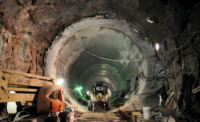When Superstorm Sandy’s massive tidal flooding finally receded in 2012, the New York region faced two daunting tasks—making tens of billions of dollars in repairs to crippled transportation infrastructure and building new defenses against future surges.
As much as any regional contractor stepping up for the work created, Judlau Contracting has been front and center.
With a public works focus since its 1981 origin as a utilities contractor, the College Point, N.Y.-based contractor has steadily built up a portfolio of transit, bridge, tunnel and water projects, with $1.2 billion in tunneling contracts in the last decade for the Metropolitan Transit Authority’s still-ongoing East Side Access transit megaproject.
Spanish contractor OHL acquired Judlau in two stages beginning in 2010, and it now operates as the Northeast U.S. arm of OHL North America, reporting $484 million in New York and New Jersey revenue last year—up 20% from 2017.
“That’s when Judlau started seeing tremendous growth,” says Ashok Patel, CEO of OHL North America since 2017 and a former MTA manager who joined Judlau in 2009. “Sandy occurred in 2012, and we took on a host of projects from all of the rehabilitation work.”
“Our flood mitigation projects for the Carey and Queens Midtown tunnels were design-build, along with other projects for [MTA] ... with a greater expectation to deliver projects on schedule and on budget.”
– Uday Durg, OHL North America Executive Vice President
Few projects capture the storm recovery mission’s scope better than Judlau’s $477-million joint venture contract with TC Electric, a firm owned by Judlau founder and former CEO Thomas Iovino, to rehabilitate the badly damaged Canarsie Tunnel serving New York City Transit’s L subway line between Brooklyn and Manhattan. Work also involves upgrades to stations bookending the two tubes.
Judlau’s work in managing the complex infrastructure repair amid fast-changing logistical and political realities was key in its selection as ENR New York’s Contractor of the Year.
Indeed, the project became a major news story on Jan. 3 when Gov. Andrew Cuomo (D) scrapped the original MTA plan—to shut down the tunnel crossing in April for 15 months of reconstruction—and adopted an alternative from independent engineering academics he tapped that would keep the line in service.
The new approach scaled back construction, but the parties haven’t disclosed the impact on Judlau’s contract value. The firm began work under the revised plan in May, says Larry Korgood, Canarsie Tunnel project director.
“It was an extremely busy time for my team—constant meetings and discussions on what could be done in what time frames and still not prolong the project,” he says. “Our dates are still pretty much in line with the original contract dates. And everything is going pretty smoothly right now.”
The new overhaul shelved the plan to demolish, remove and replace deteriorated track beds and bench walls housing power and other cables. Instead it calls for capping old structures, installing new support systems and replacing rails and ties—plus the huge coordination challenge to ensure continued subway service, Korgood says.
The project highlight may be yet another feature: a 30-ft-wide and 200-ft-long excavation for a new Manhattan substation that tapped an innovative steel sheet-driving technique to squeeze out groundwater from the space. “It hadn’t been done in the city on a scale this big,” Korgood says. “We got a lot of visits from engineering companies to see the operation.”
Judlau’s Sandy recovery portfolio also included a $115-million contract to repair the Montague R-line subway tunnel, a two-mile-long East River crossing flooded by 27 million gallons of saltwater that the firm finished two months early in 2015.
It also finished a $207-million contract to repair the flooded South Ferry subway station in 2017 and installed 50,000-lb steel floodgates and other controls at the Hugh L. Carey and Queens Midtown tunnels in a $66-million contract. The latter job won kudos from Rep. Carolyn Maloney (D), who last summer said she was “thrilled” the work “is now completed, and nine months ahead of schedule!”
But Canarsie may be Judlau’s post-Sandy signature. “We’ve done station rehabs, we’ve done tunnels and pump rooms,” Korgood says. “We’ve done all of the aspects in individual jobs. This kind of puts it all together.”
NY Roots, Growing Footprint
Iovino steered the company from a small-scale waterworks contractor to a transportation projects stalwart, says Patel. Its project sizes grew steadily, including a $100-million-plus contract in 2002 to rehabilitate elevated railway and nine stations on the White Plains Road Line in the Bronx. “In that era, that was a big contract, a big deal,” he says.
Then came East Side Access, the massive and long-controversial MTA effort to create new tunnels from Queens to Manhattan to link the Long Island Railroad to Grand Central Station, which drew interest from major global contractors. Another Spain-based firm, Dragados, teamed with Judlau, which won a first contract in 2006, eventually leading to $1.2 billion in awards and a new era of growth for the local firm.
The project presented challenges for Judlau, including a $19,000 OSHA settlement related to a 2011 construction worker fatality and other serious violations, as well as a legal battle between the firm and Dragados over management of cost overruns, which was later settled. Judlau’s work on that project ended in 2013.
Cuomo in April announced an independent construction review of the now $11-billion East Side Access project, slated to open a decade late in 2022.
Judlau also worked on the high-profile yet criticized Second Avenue Subway, the city’s largest subway expansion in decades. The contractor finished out the 72nd Street Station in a $352-million contract and handled the $228-million 63rd Street Station rehabilitation. At one point, it caught flak from an MTA board member over deadline issues, but the project eventually opened on time in December 2016 under its revised schedule.
Amid such major jobs, Judlau experienced its own evolution, as OHL completed its purchase of the firm in 2016 and Iovino departed. Since then, Judlau has grown its footprint strategically beyond New York and New Jersey, with projects in Massachusetts, Virginia, Connecticut and Illinois. Judlau also at times partners with OHL, as it has on a $408-million contract with the N.Y.C. Dept. of Design and Construction to install 47,100 ft of water mains, including trunk lines for the city’s new third water tunnel.
Judlau’s 600-strong workforce generated $578 million in total revenue last year—a big chunk of parent OHL’s $3.3 billion in global revenue and of the $1.1 billion in 2018 revenue for OHL USA, which ranks at No. 77 on ENR’s Top 400 Contractors list.
The firm is pursuing growth in major Florida, Texas and California markets, says Patel, who was project executive on the MTA’s $1-billion capital security upgrade program before joining Judlau. “He was very focused on getting things done,” says Mysore Nagaraja, former MTA Capital Construction Corp. president.
Judlau benefits from OHL’s global resources, including a concessions business aimed at public-private partnerships, varied building and industrial construction specialties and major services units, Patel adds. “Our overall strategy is aligned with OHL to expand in key markets—large opportunities where there is a lot of economic growth as well as the need for major infrastructure rehabilitation,” he says.
Judlau also has been a player in adopting new construction technologies, management systems and delivery methods such as design-build, says Uday Durg, OHL North America executive vice president.
“Our flood mitigation projects for the [Carey and Queens Midtown] tunnels were design-build, along with other projects for New York City Transit and Metro North Railroad,” he says, noting “a greater expectation to deliver projects on schedule and on budget.”
Rising Underground
Canarsie remains a showcase for Judlau even under the brighter spotlight. The project scope is an advantage, Korgood says, giving its team of more than 200 control over the three major spaces—tunnels, stations and substation.
“There is a lot of coordination and layering of activities not to have everyone stepping on each other. You can’t store things in the tunnel, and a lot of trades go through there,” he says. “And every day you have to make sure that the path is safe and secure. It’s more of a logistics challenge to get everybody working efficiently so we can keep to the schedule.”
Pressing On
A major task entails upgrades and expanded capacity to stations bookending the two tubes. At Bedford Avenue Station in Brooklyn, the team is doubling the number of stairways from platform to mezzanine to the street, adding seven overall, along with accessibility, platform, lighting, wall tile and electrical service upgrades, Korgood says. At Manhattan’s First Avenue station, the team is building two new platform entrances, chopping out existing walls and adding elevators, he says.
“Both stations remain in use,” he says. “In Brooklyn, all of our work is in the middle of the platform, so we have a lot of coordination to ensure minimal impact to the public.”
The substation excavation used an unusual “press-in method,” with a Giken silent piler methodically pushing down steel sheets to keep Manhattan’s high water table at bay but also minimizing vibrations to nearby building foundations, Korgood says. The 2- to 3-ft-wide, 33- to 46-ft-long sheets are at depths as far as 55 ft, he says.
Excavating now is done, concrete work is ongoing and the team is prepping to install transformers, breakers and switch gear, he says.
The tunnel work has strict time frames. “We only set up with what we know can get done,” he says.
The main tunnel work includes installing a fiberglass shell over existing damaged duct boxes to prevent their collapse—rather than demolishing and removing them as in the original plan—and running new armored service cables through the tunnel, he says.
The crew spends weekdays preparing for major work shifts on weekends, when there is full access to one tunnel and limited subway service in the other. When completed late next year, the new equipment will be far more resistant to submersion in floodwaters, he adds.
The firm also has contracts for work on and approaching the George Washington Bridge for the Port Authority of New York and New Jersey.
Judlau now is gearing up for another high-profile job—a $253-million contract awarded by MTA’s Bridge and Tunnel Authority to replace the six-lane roadway deck in suspended spans on the Throgs Neck Bridge connecting the Bronx and Queens, says Patel.
The project entails installation of new median and side barriers, fire standpipes and roadway lighting. “When suspension bridges get old, in addition to replacing cables and ropes, you can reduce the weight of the deck. We’re installing an orthotropic steel deck that is lighter in weight but has the same capacity,” he says. “It’s another project that shows how well-positioned we are in these markets.”












Post a comment to this article
Report Abusive Comment